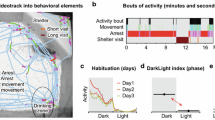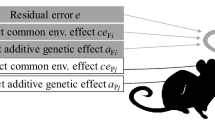Abstract
Differences of approximately 25 min in the free-running period of a circadian rhythm for wheel-running activity were observed among four inbred mouse strains (Mus musculus). Two sets of reciprocal hybrid crosses among the strains showed approximately intermediate values for circadian period in one cross and dominance for a short period in the other. Neither set of crosses showed evidence of significant maternal effects on circadian period. These results indicate that the inbred strain differences in circadian period are imposed primarily by direct effects of allelic differences among the strains, rather than through maternally mediated mechanisms.
Similar content being viewed by others
References
Bruce, V. G. (1972). Mutants of the biological clock inChlamydomonas reinhardi.Genetics 70:537–548.
Buttner, D., and Wollnik, F. (1984). Strain-differentiated circadian and ultradian rhythms in locomotor activity of the laboratory rat.Behav. Genet. 14:137–152.
Daan, S., and Berde, C. (1978). Two coupled oscillators: Simulations of the circadian pacemaker in mammalian activity rhythms.J. Theor. Biol. 70:297–313.
Davis, F. C., and Menaker, M. (1981). Development of the mouse circadian pacemaker: Independence from environmental cycles.J. Comp. Physiol. 143:527–539.
Ebihara, S., Tsuji, K., and Kondo, K. (1978). Strain differences of the mouse's free-running circadian rhythm in continuous darkness.Physiol. Behav. 20:795–799.
Ehrman, L., and Parsons, P. A. (1981).Behavior Genetics and Evolution, McGraw-Hill, New York, pp. 118–125.
Feldman, J. (1982). Genetic approaches to circadian clocks.Annu. Rev. Plant Physiol. 33:583–608.
Feldman, J. F., and Hoyle, M. N. (1973). Isolation of circadian clock mutants ofNeurospora crassa.Genetics 75:605–613.
Hegmann, J. P., and Possidente, B. (1981). Estimating genetic correlations from inbred strains.Behav. Genet. 11:103–114.
Jackson, F. R., Bargiello, T. A., Yun, S., and Young, M. W. (1986). Product ofper locus onDrosophila shares homology with proteoglycans.Nature 320:185–188.
Konopka, R. J. (1981). Genetics and development of circadian rhythms in invertebrates. In Aschoff, J. (ed.),Handbook of Behavioral Neurobiology: Biological Rhythms, Plenum Press, New York, Vol. 4, pp. 173–181.
Konopka, R. J., and Benzer, S. (1971). Clock mutants ofDrosophila melanogaster Proc. Natl. Acad. Sci. USA 68:2112–2116.
Moore-Ede, M. C., Sulzman, F. M., and Fuller, C. A. (1982).The Clocks that Time Us, Harvard University Press, Cambridge, Mass., pp. 113–151.
Pittendrigh, C. S. (1974). Circadian oscillations in cells and the circadian organization of multicellular systems. In Schmitt, F. O., and Worden, F. G. (eds.),The Neurosciences: Third Study Program, MIT Press, Cambridge, Mass., pp. 437–458.
Pittendrigh, C. S. (1981). Circadian systems: General perspectives. In Aschoff, J. (ed),Handbook of Behavioral Neurobiology: Biological Rhythms, Plenum Press, New York, Vol. 4, pp. 57–80.
Pittendrigh, C. S., and Daan, S. (1976). A functional analysis of circadian pacemakers in nocturnal rodents. I–V.J. Comp. Physiol. 106:223–355.
Possidente, B. P., and Hegmann, J. P. (1980). Circadian complexes under common gene control.J. Comp. Physiol. 139:121–125.
Scheuch, G. C., Johnson, W., Connor, R. L., and Silver, J. (1982). Investigation of circadian rhythms in a genetically anophthalmic mouse strain: Correlation of activity patterns with suprachiasmatic nuclei hypogenesis.J. Comp. Physiol. 149:333–338.
Stephan, F. K. (1986). The role of period and phase in interactions between feeding- and light-entrainable circadian rhythms.Physiol. Behav. 36:151–158.
Author information
Authors and Affiliations
Additional information
This material is based upon work supported by the National Science Foundation under Grant PDF-8166034.
Rights and permissions
About this article
Cite this article
Possidente, B., Stephan, F.K. Circadian period in mice: Analysis of genetic and maternal contributions to inbred strain differences. Behav Genet 18, 109–117 (1988). https://doi.org/10.1007/BF01067080
Received:
Accepted:
Issue Date:
DOI: https://doi.org/10.1007/BF01067080




